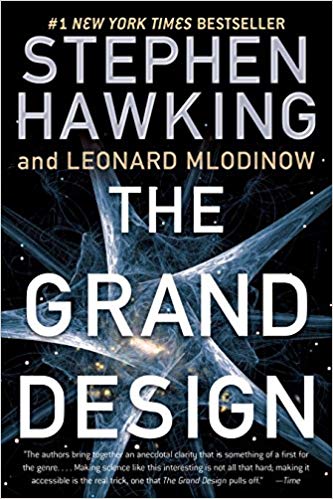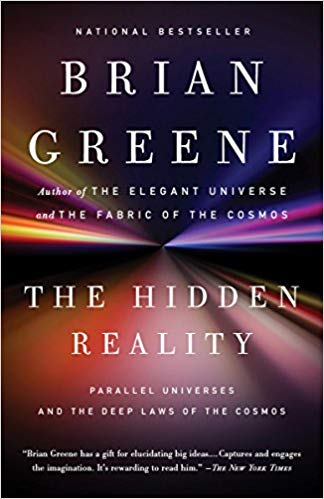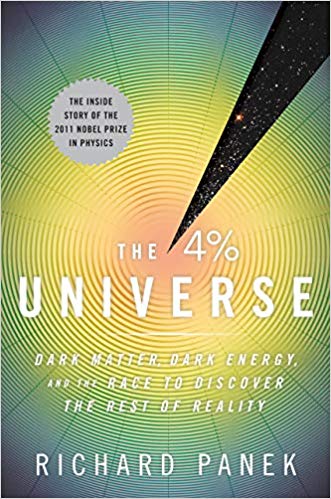The Bubble Machine
The Grand Design
Stephen Hawking and Leonard Mlodinow. 2010. Random House, Bantam Books, New York. 208 pages.
The Hidden Reality: Parallel Universes and the Deep Laws of the Cosmos
Brian Greene. 2011. Penguin Books, Allen Lane, London. 384 pages.
The 4 Percent Universe: Dark Matter, Dark Energy, and the Race to Discover the Rest of Reality
Richard Panek. 2011. Houghton Mifflin Harcourt, New York. 320 pages.
The mystery of the universe—why it exists at all, let alone why we are here—has been a perpetual torment to humankind. Even today, King David’s observation millennia ago sums up our collective query: “When I look at your heavens, the work of your fingers, the moon and the stars, which you have set in place, what is man that you are mindful of him, and the son of man that you care for him?” (Psalm 8:3–4).
Modern science has taken the tack that investigating the physical world on ever-smaller scales will reveal an answer. Certainly it will not be an answer that will explain why God would bother with such a scheme in the first place, or why He should care for His creation. But the scientific hope is that by understanding the pieces and forces that contribute to the structure of the universe we will be able to reconstruct the backstory of our existence.
Where are we today in this quest?
If we ever find out why we and the universe exist, “it would be the ultimate triumph of human reason . . .” wrote Stephen Hawking in his well-received 1988 book A Brief History of Time. Part of that positive reception was no doubt due to his follow-on to that bold statement: “—for then we would know the mind of God.”
The Mind of God
Statements like Hawking’s draw our attention and resonate with our deep desire to understand the world and ourselves. A reader thus begins Hawking and Mlodinow’s The Grand Design with some sense of intrigue: Will they discover a Designer, a cause, an ultimate answer? “To understand the universe at the deepest level,” they suggest, “we need to know not only how the universe behaves, but why.”
Like the human mind, the universe seems to be just a bit too “right” to explain it all away as an accidental collection of bits that synergize into a greater whole. At times The Grand Design tends toward that conclusion as well. “The emergence of complex structures capable of supporting intelligent observers seems to be very fragile,” they write. “The laws of nature form a system that is extremely fine-tuned, and very little in physical law can be altered without destroying the possibility of the development of life as we know it. Were it not for a series of startling coincidences in the precise details of physical law, it seems, humans and similar life forms would never have come into being.”
But Hawking never meant to imply that there really is a mind of God to know; as remarkable as the universe is, it really is just a coincidence. And 20-plus years of further thought on the matter have not brought him to an Antony Flew–like conversion. (Flew, a leading atheistic philosopher [1923–2010], finally concluded that to “follow the evidence wherever it leads” must in fact lead to “an Intelligence that produced the integrative complexity of creation.”)
According to Hawking and Mlodinow, the theory of continuous creation that results in a bubbling up of universes ad infinitum makes the concept of a Creator irrelevant, redundant, unnecessary, vestigial. We get the point: the grand design is no design. The need for an “intelligence” to create a universe to sustain our presence is instead a grand illusion: “The multiverse concept can explain the fine-tuning of physical law without the need for a benevolent creator who made the universe for our benefit.”
“Bodies such as stars or black holes cannot just appear out of nothing. But a whole universe can.”
This bubble machine/universe-maker is vaguely outlined as M-theory—vague in that even these writers do not know what the M stands for: Master? Miracle? Mystery? “It seems to be all three,” they note. Whatever its origin, the theory is designed to account for that remarkable coincidence of a universe apparently made for intelligent life—for man. (Maybe that’s the M.)
One might also speculate that M stands for Many (or Multiverse) because that is the ultimate suggestion of the theory: ours is only one of an infinite number of universes. Or at least one of 10500 universes. “To get an idea how many that is, think about this,” suggest Hawking and Mlodinow. “If some being could analyze the laws predicted for each of those universes in just one millisecond and had started working on it at the big bang [ca. 14 billion years ago], at present that being would have studied just 1020 of them. And that’s without coffee breaks.”
Those little sparkles keep the reader engaged, but ultimately the explanation that the quantum bubble machine just keeps on bubbling is unsatisfying. “Spontaneous creation is the reason there is something rather than nothing,” they conclude. “It is not necessary to invoke God to light the blue touch paper and set the universe going.” They step out farther to suggest that “M-theory is the unified theory Einstein was hoping to find”—a strange remark when one remembers that Einstein did not like the idea of God “playing dice” with the laws of reality. Thus The Grand Design clangs along, but without offering the ring of truth.
The Universe in a Cheese Ball
Tossing his ideas on the table is physicist and string theory advocate Brian Greene. Dissecting all the ways in which universes might just appear spontaneously is his territory in The Hidden Reality. The less dense, more readable Grand Design can be viewed as the pop version of Greene’s work; he abandons levity in favor of bolting the gravitas of string theory to the discussion.
While Hawking and Mlodinow use the phrase model-dependent realism (to describe the idea that it is reasonable to prove the existence of multiple universes through mathematical modeling), Greene invokes the “principle of fecundity” to describe the continuous creation of new universes: living things have the capacity to reproduce exponentially, so why not universes?
The patient reader will learn that, once again, no design is the best design, and given enough universes, one will be just right for us (because, after all, one is!). But why does this universe have all the proper physical parameters for life? Why have we won the jackpot? “These universes instantiate all possible mathematical equations,” Greene explains. In other words, if you have a lottery ticket for every possible winning number, you are sure to win. “Our ‘everything,’” he says, “may be just one enormous expanding bubble in a gigantic cosmic bubble bath of universes.”
“I have little doubt that future generations will look back upon our work in the twentieth and twenty-first centuries as having nobly laid the basis for whatever picture finally emerges.”
The most common way to picture an expanding universe is with a balloon. We are on the balloon, not inside it. As the balloon fills, the fabric stretches and galaxies move apart. Greene’s picture of the multiverse goes one step farther: think of the cosmos as a giant block of Swiss cheese. Our universe is just one bubble within the block. The holes, and there are many of them, “have transitioned out of the superfast expansion,” Greene writes.
A very important part of the big bang paradigm is an unusual and strictly hypothetical era called inflation. Created as a mathematical way to explain the slight irregularities from which stars and galaxies are believed to have originally formed, the inflationary epoch—or “superfast expansion”—has become foundational in describing the initial conditions of our universe. In the multiverse, each point of expansion is a new roll of the cosmic dice. We are here because the laws of our universe came up just right, as they were sure to do, because even if there actually is no statistical probability of this happening, an infinite number of rolls (and this, of course, is a critical assumption) makes the impossible possible.
According to the hypothesis, gravitational interactions in these inflation-driven areas eventually cause particles to form. As the universe expands and cools, these particles condense to become us—the atoms of stars, planets, rocks and cells. Greene assures that the non-hole areas of the metaphorical cheese also continue to expand so that one universe does not overlap with another.
“Taken together, the two processes yield an ever-expanding block of cosmic cheese riddled with an ever-growing number of holes. In the more standard language of cosmology, each hole is called a bubble universe (or a pocket universe). Each is an opening tucked within the superfast stretching cosmic expanse.”
Burst Bubble
It is the big bang (and bang, and bang, and bang, 10500 times, apparently) that the rules of science allow, not “In the beginning, God . . .”. But although the supernatural—that which is beyond the laws of nature—is out of bounds when it comes to describing origins in a scientific way, where is the science in devising theories that have no observational basis? Is model-dependent realism science or art? These are popular books by popular writers, but their basis is the same one used by J.K. Rowling in her Harry Potter series: a vivid imagination.
Science is about empirical data and quantifiable and testable hypotheses. These set boundary lines rightly exclude nonphysical explanations. Yet a “theory” in science is defined as something substantially if not wholly based on observation that predicts further observations. Hawking and Mlodinow’s last-sentence disclaimer, “If the theory is confirmed by observation. . . ,” seems too weak.
“The beauty of physics, its raison d’être,” Greene writes, “is that it offers insights into why things in the universe behave the way they do. The ability to predict behavior is a big part of physics’ power, but the heart of physics would be lost if it didn’t give us a deep understanding of the hidden reality underlying what we observe.” That sounds reasonable enough.
But the multiverse, M-theory and most of what Greene describes as viable contingencies fail the empirical boundaries rationale. Greene suggests a possible test, but it is circular at best: “Atypical” things, like us, might happen in some unknown way, but how does one measure this? “The less typical we are, the less compelling the given multiverse proposal would be. If among all life-supporting universes in a given multiverse our universe would stick out like a sore thumb, that would provide a strong argument to deem that multiverse proposal irrelevant.” In other words, if we are unique, then maybe something truly different has happened, but we really cannot examine our uniqueness because other universes are not at our disposal to examine, so we probably aren’t special because the math tells us so.
Hmm . . .
Cosmologists agree that the assumptions underlying the notion of parallel universes are mathematical constructs, not measured reality. In this regard 1998 Nobel-winning physicist Robert Laughlin told Vision, “I’m a man who doesn’t like to mix up what he measures with what he believes.”
In his book A Different Universe (2005), Laughlin warns of “delusional traps” that generate “alternative ‘explanations’ for things that cannot be distinguished by experiment.” Such ambiguities “facilitate fraud, in that they allow a thing to be labeled quantitative and scientific when it is, in fact, so sensitive to the whim of the measurer that it is effectively an opinion.” String Theory (and its descendant, M-theory) “has no practical utility,” Laughlin insists, “other than to sustain the myth of the ultimate theory. There is no experimental evidence for the existence of strings in nature, nor does the special mathematics of string theory enable known experimental behavior to be calculated or predicted more easily.”
He writes, “A measurement that cannot be done accurately, or that cannot be reproduced even if it is accurate, can never be divorced from politics and must therefore generate mythologies.” So what of these ideas? Are they actually taking us closer to understanding the universe? “When thinking about this, my mind fills with storm clouds,” Laughlin told Vision. “All physicists, myself included, are reductionists at heart. It’s just that some of us are more faithful to the ethic of putting nature first and our own egos second.”
Dark and Missing Pieces
All of this simply means that one must be aware of the difference between conjecture and fact. The increasingly convoluted cosmological theories employ both science and art because the universe is so quirky. As the observational base of astronomy has advanced (especially since the 1990 launch of the Hubble Space Telescope), theoretical cosmology—the realm of Hawking and Greene—has sought to account for increasingly bizarre findings, including forces of gravity and energy that seem to have no source.
Science writer Richard Panek summarizes the puzzle: “The more we could observe, the more we would know. But what about the less we could observe? What happens to our understanding of the universe then?” In The 4 Percent Universe, Panek chronicles the evidence indicating that 96 percent of the universe is not only invisible but remains incomprehensible. This is the realm of dark matter and dark energy.
The book falls in sequence with Panek’s two previous works. His history of the telescope, Seeing and Believing (1998), set the stage for this new book by outlining modern astronomy from Galileo forward. His second in 2004, The Invisible Century, journeyed into psychology and the big bang. His conclusion is a preamble for his new book: “Invisible-light astronomy and psychoanalytic technique arose out of a common need and have grown to create a common vision: not that there is more to the universe than meets the naked eye, and not that there is more to the universe than meets a naked eye assisted by instruments that extend the sense of sight, but that there is more to the universe than meets the eye at all.”
Panek offers an account of how astrophysicists have discerned not only the expansion of the universe but also the acceleration of the rate of expansion. This finding has been just as surprising as the discovery of expansion in the first place; even Einstein had originally fudged his calculations concerning the structure of the universe to keep it from collapsing, not to keep it from blowing apart. One does not need to be an Einstein to recognize that the gravity intrinsic to the mass of the universe would tend to pull everything together into one big blob.
Since that had not happened, Einstein added a factor he called the cosmological constant into his equations to maintain a stable state, a kind of anti-collapse energy. When acceptance of an expanding universe became required, Einstein tossed the cosmological constant. For decades after, the great mystery of cosmology was whether the universe keeps expanding forever. Or does the big bang cycle back to the “gnab gib” (reverse big bang) and the whole system reboot itself? That would certainly solve the problem of an ultimate beginning event.
Now it seems the cagey Einstein may have had the right idea all along. His “biggest blunder” has been resurrected as a force called “dark energy”—a kind of antigravity that makes the universe expand faster as time goes by. This comes on the back of dark matter, a mystery substance invented to account for the unusual motion of galaxies themselves.
Nothing is simple in the cosmos. Normal matter, made of atoms and their smaller constituents, is visible; it interacts with light and we can detect it in myriad ways, including its gravitational effect. That is the 4 percent of Panek’s title. Along with dark energy (accounting for about 72 percent of the universe), which causes the large-scale expansion to press outward with increasing force, dark matter (about 23 percent) adds gravity that mysteriously pulls together large-scale structures such as galaxies.
Panek goes deep into the give-and-take between individuals involved in making new discoveries, the conferences they attended, and the correspondence they had. But after interviewing 91 scientists and compiling almost 150 books and articles in his bibliography, Panek may have overwhelmed even himself on this one. His previous books demonstrate that such deep preparation is his standard practice, and although he hits the big names in the story, something is missing. In the end, simply parroting the same multiverse scenarios to explain these new qualities that again must be “just right” is frustrating, a bell without a clapper. Panek’s own conclusion is that a “revolution in thought” is mandated by recent cosmological studies and that this will require a “new physics.”
Beyond the Void
It is, of course, interesting that once again humankind discovers itself in a place and time when these observations can be made and interesting questions asked. For, if this cosmic timeline is correct, in the future the universe will have expanded beyond our ability to observe it. Imagine—we could have found ourselves, one supposes, in a very different kind of place. The night sky could have been much darker; there would be fewer stars, and the rest of the universe would have moved beyond even our most powerful possible telescopes. It would indeed be an even lonelier place.
Concerning questions of origins and the rules that guide the structure of the universe, physicist Laughlin believes that science may one day have the capacity to provide answers, but not yet. “[You may postulate] the existence of the Fundamentally Unquantifiable,” he suggests. “You’re free to do that, of course, but I prefer to say that there are things I can’t know right now because I don’t have the proper tools. What’s blocking me isn’t my own lack of cleverness, of course, but physical law itself. It is a law that things emerge, not a serendipitous accident. Perhaps people will never have the proper tools, in which case they’ll definitely never know [these] things, but I don’t see much point in speculating about this. Right now certain things are functionally unknowable.”
In the best circumstances, then, science would be neutral to the concept of a Creator. Clearly, as Laughlin and we all intuitively understand, there must be ultimate causes, even if we cannot yet discern them. It is unfortunate and unnecessary that some use their scientific credentials to cast a limitation on what those ultimate causes might be. And others, as we see in these books, imply that there is more scientific objectivity to their cosmological musings than actually exists. In seeking to erase the fingerprints of a Creator, they push faith in physical understanding beyond its limits.
Even if we imagine the M in “M-theory” to stand for Mind, such a designing mind would be a hidden reality, invisible to physical probing. While the observations of science reveal astounding complexities of the cosmos, it would nevertheless be the pinnacle of human arrogance to suggest that science could describe the underlying grand design; although humanity will likely continue to view science and theory as its revelators, other sources are necessary to make known the unknowable.
To insist that the universe is accidental—now pictured as a single bubble within a cosmic foam—is a choice of belief, not an empirical conclusion.




